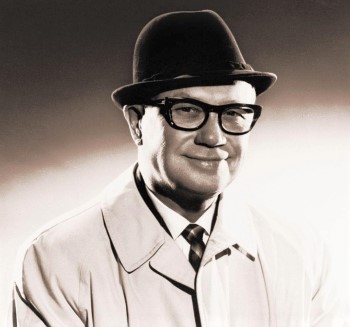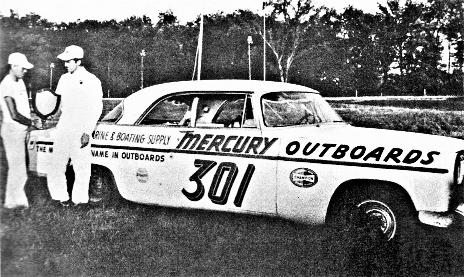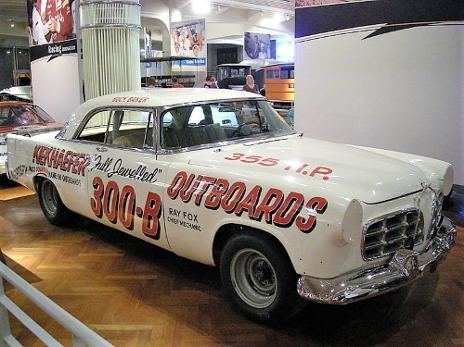CARL KIEKHAEFER
06-04-1906 - 10-05-1983

In 1927 Keikhaefer briefly worked as a draftsman by Evinrude Motors before being fired for "...frequent, disquieting and brazenly insubordinate arguments concerning design and product development...". He was a young engineer right out of college when he received his first of his over 200 patents. He purchased an outboard motor manufacturing company in Cedarburg, Wisconsin in 1939, intending to make magnetic separators for the area's dairy industry. The company had 300 defective motors, which he rebuilt and sold to catalog company Montgomery Ward. Orders kept coming for the motors, and Kiekhaefer Corporation was born. Kiekhafer's company would eventually end up being know as Mercury Marine. Kiekhaefer decided to use car racing to promote his now profitable boat motor company. He entered 1954 Chrysler New Yorker club coupes in the AAA Milwaukee Mile and won all three races entered. Tony Bettenhausen and Frank Mundy drove. He then purchased large and powerful Chrysler 300s to use in NASCAR for the 1955 season. Kiekhaefer was a millionaire
so he could afford the expensive cars unlike the other teams. He bought the best equipment, and had a team, as well as transporters, unheard of in NASCAR at the time. He brought his car with no driver to the first race at the Daytona Beach Road Course. Retired former champion Tim Flock had retired after the 1954 season, but was convinced to return by Kiekhaefer for $40,000. Carl fielded cars for six different drivers in 1955. Four of them ran a total of six races. Fonty Flock ran 20 races for Kiekhaefer, while Tim Flock ran 38 of the 45 races that season. Fonty would win two races, while Tim would visit victory lane 18 times and post 32 top ten finishes. He would go on to win the Cup Championship title, while his team mate Buck Baker would finish second. Kiekhaefer and Flock had a falling out early in the 1956 season. Buck Baker was number one driver for the team. Baker entered 44 events, with 14 wins, 12 poles and 35 Top-10 finishes on his way to the team's

Tim Flock

Fonty Flock
second consecutive championship. Speedy Thompson also drove for the team, entering 39 events, with 8 wins, 7 poles, and 28 Top-10 finishes on his way to third place in the points. Herb Thomas would finish second in the points. Kiekhaefer had nine drivers race for him in the 56 event season, taking first, second, third, and ninth in the final series points. The drivers combined for 30 wins, 25 poles, and 92 Top-10 finishes in their 126 races. Four drivers combined for 16 straight team wins between March 25 and June 3. Kiekhaefer quit NASCAR in January 1957 after battling Bill France, over accusations of cheating by the other competitors (though no rules infractions were found under NASCAR's close scrutiny), NASCAR changed the rules
to Kiekhaefer's disadvantage, and he did not want a backlash to affect Mercury sales after fans booed the team. While not the first "superteam" in NASCAR history, the Mercury Marine team was legendary. Even though he only fielded cars for two season, he had some impressive stats. His drivers won the CUP Championship both years, and also had a driver finish second both years. His driver posted 190 starts, and grabbed 52 wins (an impressive 27%.) while posting 166 top fives, (61%) and 139 top tens. (73%). Kiekhaefer was an innovator. Some of the things he is noted for are: His team was the first to use dry paper air filters, which are now standard equipment in today's cars. First to do scientific testing of the oil in his race car motors to see what was affecting the performance of his motors via contamination. First professional team. The cars were professionally painted and detailed. Team members wore uniforms. At a time when most drivers

Buck Baker

Speedy Thompson
drove their cars to the track, Kiekhaefer used the Mercury Marine box or "van" style trucks with the race cars sticking out the back due to their length. Multiple photos support this. The floors of the trucks had jacks built into them to support the cars on their frames so they would not ride on their wheel and axle bearings during transport to and from races. Had the first major national sponsor to NASCAR (excluding automotive-related companies). Set a record lap of 140 mph at the Daytona Beach Road Course.
All Photos copyright and are property of their respective owners
